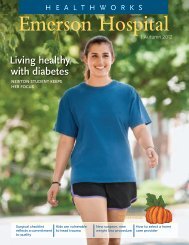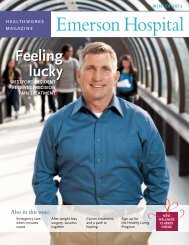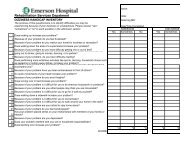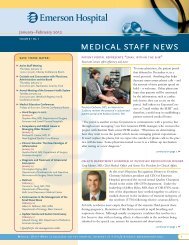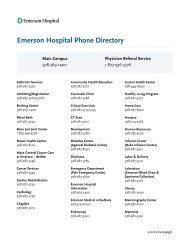Create successful ePaper yourself
Turn your PDF publications into a flip-book with our unique Google optimized e-Paper software.
Cover feature | Expertise and cooperation lead to a successful outcomeExpertise and cooperationlead to a successful outcomeCarlisle resident avoids paralysis thanks to swift diagnosis, treatmentMeghan O’Sullivan will never forget that day. Neither will the physicians at<strong>Emerson</strong> who moved quickly to diagnose her serious and rapidly progressive condition.Within hours, Ms. O’Sullivan was having emergency neurosurgery that, allagree, saved her from paralysis. Her story, which unfolded on a Friday afternoonlast June, is a model of how medical and surgical expertise, cooperation and acomprehensive system of care can serve a patient’s needs.Ms. O’Sullivan, 44, a Carlisle resident, developedsymptoms that became increasinglytroubling and confusing. “I had backspasms for about a month, so I was gettingdeep-tissue massage and seeing a chiropractor,”she explains. “Then I began to haveacute pain – serious pain – in my neck anddown my arm.” Soon, her right hand becamenumb and progressively weak.What happened next convinced her to callAlan Marks, MD, a rheumatologist at<strong>Emerson</strong> who previously treated her for bursitisand tendonitis. “I woke up that Fridayand noticed my eye was drooping,” she recalls.“My foot was weak, and I started tolimp. I thought it could be a pinched nerve;I probably needed a stronger muscle relaxantto get through the weekend.”Specialists move quickly to make thediagnosisDr. Marks made time in his schedule to seeMs. O’Sullivan and conducted a thoroughexam and health history. “When she camein at 1:00 that day, it was clear to me thatMeghan had a major problem,” he recalls.“Pain in one’s neck that goes down the armis not uncommon; I was concerned with theweakness in her hand, and the fact that shewas limping. It was clear she had a cervicalspinal cord problem, of which a ruptureddisc is the most common cause.A swift diagnosis by <strong>Emerson</strong> specialists savedMeghan O’Sullivan from paralysis.“I knew Meghan to be an active, healthy personwho ran and played tennis,” he adds.“In my office that day, she was gettingweaker before my eyes.” Ms. O’Sullivandidn’t share her worst fears: she had begunto worry that her symptoms could be multiplesclerosis.Dr. Marks phoned Agnes Virga, MD, the<strong>Emerson</strong> neurologist who was on call thatday. “I described my findings to Dr. Virga,who asked a few specific questions,” saysDr. Marks. “Together, we concluded thatMeghan needed to have an MRI scan performedright away.” He called the radiologydepartment, and Corinne Sadoski, MD, saidto send Meghan right over.By about 3:00, Dr. Sadoski had reviewed theMRI scan and phoned Dr. Marks with theresults: the disc in Ms. O’Sullivan’s neckhad ruptured and appeared to be puttingpressure on her spinal cord. “Dr. Sadoskisaid it was the largest ruptured disc she hadever seen,” adds Dr. Marks. “It explainedthe weakness in Meghan’s right arm andleg, and it confirmed that this was an emergency,because pressure on the spinal cordcan result in permanent damage.”He conferred again with Dr. Virga. Theyagreed that, late on a Friday afternoon, themost efficient step was to call theEmergency Department at Lahey Clinic andask that a neurosurgery team be assembled.Haran Ramachandran, MD, a neurosurgeonaffiliated with the Lahey Spine Program at<strong>Emerson</strong> <strong>Hospital</strong>, was on call.An injured spinal cord and a seriouscomplicationSpinal cord compression is fairly common,Dr. Ramachandran notes. “We see it all thetime,” he says. However, Ms. O’Sullivan’scase was in a completely different category.“The MRI showed that the disc hadbreached the dura – it had penetrated thespinal cord’s protective covering – which isvery unusual and was the reason she deterioratedso rapidly. It meant that the clockwas ticking. I could see there were changesin the spinal cord, so the nerves had been affected.This implied that, after surgery, improvementwould not be immediate.”4



